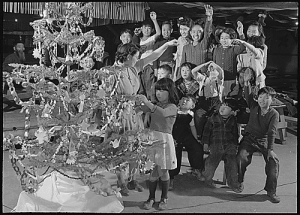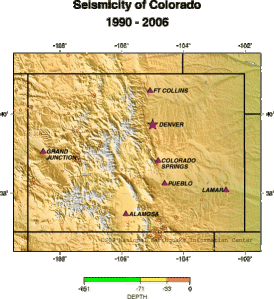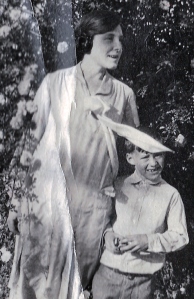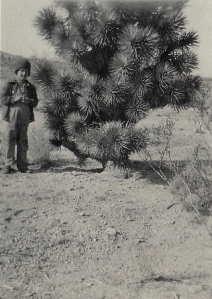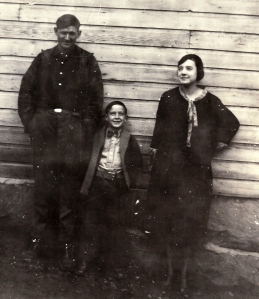Memorials
In working with the cemetery records and obituaries, I’ve found quite a few names which were left off the cemetery list. Some of those include tombstones for people who aren’t actually buried in the cemetery, and those seem to be more common now that more people are cremated; a family might choose to scatter ashes on a favorite mountain, but they still place a tombstone in the cemetery.
Other memorials are more obvious. There are memorials erected by organizations, such as the tree planted by the A.F.& A.M. (Click on the photos to see the original on Flickr).
Or the flagpole erected by the American Legion to honor veterans.
Sometimes memorials are dedicated to individuals, such as this memorial to George Ellery Brosius.
“In memory of”
2ND LT George Ellery Brosius
Born Sept. 17, 1922
P38 FIGHTER PILOT
MISSING JUNE 5, 1945
70 COMBAT MISSIONS
I’ve always been grateful that they erected that memorial to George so that every visitor to the cemetery can remember him.
Clarence Owen
In our cemetery, if you have a tiny sticker on your tombstone, it indicates that you’re a veteran. On Memorial Day, the local American Legion group decorates every grave with a sticker. What if you lack a tombstone, or your sticker wears off? You don’t get a flag.
Lisa, a woman in a nearby town is on a mission to get tombstones for the graves of any veteran in our county who doesn’t have a marker, so I set about getting her a list of unmarked veterans’ graves in our cemetery. Over a decade ago, the Colorado State Archives had a list of veterans’ grave registrations which I’d use to compile a list for our local American Legion group when they wanted to decorate veterans’ graves. But that list was no longer on the website, so I resorted to the Wayback Machine to retrieve the list. Since I subsribe to Fold3, I can easily access documents related to veterans, but I had trouble finding information on Clarence Owen, partly because the cemetery records lacked a birthdate, and the list of vets didn’t say what war he served in.
Is he the Clarence Owen who served in Company E of the 14th Regiment, US Infantry (Regular Army) during the Civil War? It’s possible, because other Civil War soldiers in our cemetery lived into the 1930s. I scoured the local newspaper for information, but didn’t find an obituary. Mesa County Public Library has their obituary index online, and they listed two notices for Clarence, one in May, one in September. Last week, I finally made it down to the library to check the notices. The first one mentioned that he’d died, and they thought he had a couple of sisters, one living in Gunnison. The second one said they’d been unable to contact any relatives, and so they’d buried him.
This summer, Bill unearthed his temporary marker. I’ll keep trying to find out more about Clarence, but it’s possible that this is the only marker he’ll ever have.
On the impossibility of accurately describing who is in the cemetery
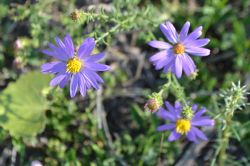
Rose Hill Cemetery has a potter’s field, a charity area where purple asters and other wildflowers grow amid tall grasses, rabbitbrush, and lilies someone planted long ago. Some of the graves are marked with tombstones, but most are unmarked, or marked with twisted metal markers which have no names. In the late 1990s, I asked Orval Sowder, my town’s former mortician, if he knew who was buried there, and he said that if someone kept records, he had been unable to find them. The people buried there are largely unknown and unknowable.
In the many decades before DNA testing was available, bodies were found, buried, and forgotten because there was no way to identify them. Thus, in the July 30, 1909 edition of the Rifle Reveille, there’s an article entitled Dead Man Found on a Sand Drift:
J.J. Saites, a colored man employed on the section gang found the body of a dead man on a sand bar in the middle of the Grand [now Colorado] River one half mile below Rifle Thursday morning about 11 o’clock. While fishing on the south bank of the river Saites noticed something that resembled a human foot on a sandbar. He crossed the small channel of the river and discovered the body lying face up in the edge of the water…The body was that of a young man about 30 years old and weighing perhaps 135 pounds. He was about 5 feet four inches in height. There being no clothing on the body it is supposed that he drowned while swimming…
In the graphic detail typical of the time, the article describes the body: [It] was in a bad state of decomposition, and evidently had been there for a week as the skin was badly burned by the sun and the hair had nearly all fallen off the scalp. Identification is probably impossible on account of the sunken and decomposed condition of the face.
They added that the body was buried at the cemetery.
When I read articles like that, I want to say, “Hey, keep a sample of his hair and maybe we can figure out who he’s related to in a hundred years.” However, these were people who didn’t even keep accurate records. They seemed to think they’d live forever, so no one would need an accurate map of who was buried in the charity section. I know that in geological terms, it doesn’t matter, but when I read a story like that, it matters to me because I want to know where he ended up. After all, I’m human, and humans are irrational.
The closing of Granada
The National Archives “Today’s Document” shows a photo from the closing of Colorado’s Granada Relocation Center on October 15th, 1945.
I’ve noticed that one reason I so seldom post to this blog is because it takes awhile to do the research that backs up an entry. So today, I’ll just leave you with some pertinent links about Granada.
Governor Ralph Carr is profiled by the Colorado State Archives, which includes this quotation: One of the few voices of reason during wartime was Governor Carr, who continued to treat the Japanese-Americans with respect and sought to help them keep their American citizenship. He sacrificed his political career to bravely confront the often dark side of human nature. “If you harm them, you must harm me. I was brought up in a small town where I knew the shame and dishonor of race hatred. I grew to despise it because it threatened the happiness of you and you and you.”
The book to read about Governor Carr is The Principled Politican by Adam Schrager which I own, but have yet to read. An indication of his reputation in modern-day Colorado is a building project named after him, the Ralph Carr Colorado Judicial Center Building, which you can learn more about here.
An interesting blog post about recent archaeological finds is here. That article includes a link to the Amache Preservation Society, which includes some primary source documents.
The Colorado Archives has information about the camp itself here and links for more information here. The National Archives has an “exhibition” about the camp here. You can find photographs like the one that illustrates this blog post by searching in Flickr: The Commons.
Christo and Jeanne-Claude’s Colorado Curtain
Christo and his wife Jean-Claude (along with their 13-year-old-son) lived in the trashiest apartments in Rifle for most of the two years it took them to hang the Valley Curtain across Rifle Gap. The apartments are still trashy and still lived in, though not by world-famous artists.
I read a lot of negative things about Christo’s proposal to drape the Arkansas River Valley, but even though we knew he was eccentric, if not crazy, to hang a curtain near Rifle, it was a unique experience for those of us who lived here then. Since part of my story about the curtain is something I only tell close friends, maybe I’ll write it and let someone post it for me posthumously (which means it could appear in several decades).
Yes, it was a strange project. But yes, it was also strangely beautiful. We were lucky that he chose our valley. If you want to know what it felt like to live in Rifle then, check out the movie The Dish. Our town was a lot like that town.
Mrs. Murphy freezes to death in a ditch
Occasionally, you run across a story that sticks with you. I’m not sure why I thought of Mrs. Murphy today; perhaps it’s because she was a mother and it’s almost Mother’s Day. I read about her over a decade ago, but I’m not even sure which decade she died, although it seems as though it happened before 1900. The story is something like this:
Mrs. Murphy was found frozen to death in a ditch. She’d last been seen alive staggering out of one of the local saloons, and perhaps in her drunken state, when she fell in the ditch, she was unable to get out and too drunk to know the difference, and so she fell asleep and died. She was married to Patrick Murphy, a miner, had five children, and was to be buried in Carbondale’s Marion Cemetery
Who knows which of those details are accurate? I certainly don’t. I wasn’t searching for Mrs. Murphy when I read the paper on microfilm–it was chance that led me to read her story.
I’ve searched for the story again in Colorado’s online newspapers, but without success. Why do I remember the story? It’s the details. She was falling-down drunk, but no one took care to see that she made it safely home. She had five children, but she’d left them alone while she went to the saloon. Also, the article didn’t bother to mention her name. It wasn’t Mrs. Bertha Murphy or Mrs. Margaret Murphy–she was only Mrs. Patrick Murphy–just a drunk, dead, first-nameless, negligent mother found frozen in a ditch, apparently buried in an unmarked grave.
Happy Mother’s Day.
The Denver earthquake series of the 1960s
Subtitle: How to cause an earthquake.
The USGS has websites of earthquake history for each state. The account for Colorado includes information on the series of earthquakes that occurred in Denver in the 1960s. When and why did the earthquakes start?
“In 1961, a 12,000-foot well was drilled at the Rocky Mountain Arsenal, northeast of Denver, for disposing of waste fluids from Arsenal operations. Injection was commenced March 1962, and an unusual series of earthquakes erupted in the area shortly after.”
In fact, the earthquakes continued through the 1960s so “in September of …[1968], the Army began removing fluid from the Arsenal well at a very slow rate, in hope that earthquake activity would lessen.”
Resources:
The trip home from Phoenix
The family spent several months in Phoenix before they headed back to Colorado. The photo above is of Leona and Joe in Phoenix. Judging by the bow on her dress, it must have been a windy day.
This part of the story details Grandma’s story of the return trip through Gallup where Grandpa cooked breakfast on the campfire and they picked up a couple of hitchhikers.
Crossing the Colorado–twice?
My grandmother continues telling the story of the trip to Phoenix. They traded for a new vehicle in Topock, Arizona, then they drove it over “that big high bridge” across the Colorado River. She then tells the story of crossing the Colorado River on the ferry. Does this mean they had to cross the Colorado again? Which ferry was it? My father’s favorite story about the trip was that they arrived in Phoenix with snow in their vehicle. Since the Phoenix children seldom saw snow, this was exciting to them. My confusion continues about the exact route they took to Phoenix. Perhaps the ferry trip happened on the way back to Colorado in the spring and Grandma conflated the two events in her story. Too bad I can’t ask.
I’m always struck by how small Phoenix seemed to be in 1926-27. According to the City of Phoenix, the population in 1930 was 48, 118.
Click on the link below to hear the story.
Resources:
Arizona Roads historic maps, including a 1927 Arizona highway map
Arizona road map from Wikimedia commons
Trip to Phoenix
My grandmother was a storyteller.
One of her best stories was about a trip she, her husband, and my dad made from Rifle, Colorado to Phoenix, Arizona in November 1926. I recorded her telling this story in the late 1970s. Recently, I converted the audiocassette using Audacity, so I’m posting the story in three parts.
The main people she mentions in the story are “Joe’s dad” (Gene Crook), herself (Leona), and her son Joe (my dad). They were headed to Phoenix to visit/temporarily live with Gene’s sister Sue Eschelbach and her family.
I used to think that they’d crossed the Colorado River at Lee’s Ferry. Grandma herself may have told me that, or perhaps in a different version of the story, she talked about crossing Lee’s Ferry on the return trip. However, based on the few places she mentions on the trip, they must have crossed over the Colorado between Needles and Kingman, Arizona (of course, I wish I’d asked at the time).
The trip took them several weeks, in part because they had to stop and buy a new vehicle on the way.
The story reveals a lot about transportation in the 1920s western United States. Although she reveled in telling about the journey, I think this trip might be one of the reasons that my grandmother generally preferred to stay home for the remaining decades of her life.
The first part of the story talks about the trip from Rifle through Helper, Utah (where they spent Thanksgiving) to Needles, California. Click on the link below to hear the story.
